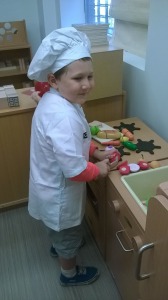Why Is My Child Tantruming?
A toddler temper tantrum can come on suddenly and strong. On the blog Reasons My Son is Crying, parents make light of the fact that anything from soup being served in the wrong bowl to hair falling in eyes can set a little one off. Young children aged 1 to 3 are particularly prone to tantrums.
Don’t panic that your angel is turning into a tyrant! Take comfort; at this age, your child is most likely not throwing a fit to manipulate you. While still in this learning-how-to-talk phase, children don’t have a firm grasp of translating emotions and desires into words, and this is frustrating, which leads to meltdowns.
Seven Tips for Handling a Temper Tantrum:
1. Keep your cool. Temper tantrums can range from incessant whining and crying to kicking, screaming, and pounding the floor, all the way to hitting, throwing objects, and holding her breath until she’s turning blue. We know it’s difficult to handle, but you can rest easy that even holding his breath is within the normal range of behavior for a mid-tantrum child.
When your toddler is in full swing tantrum mode, he can’t process reasoning, though he will respond – negatively – to your threatening or yelling. “I found the more I shouted at Brandon to stop, the wilder he would get,” comments one tot mom. She discovered that what worked for them instead was to sit down and just be together through his fit.
As a general rule, staying with your child through her tantrum is a good idea. Stomping away can make her feel abandoned. The mass of emotion he’s feeling can be frightening, and knowing you’re nearby is a source of comfort.
If you find your frustration overwhelms you, it may help to calmly leave the room, after making sure it’s a safe space or someone else is watching your child, for a short while and returning after he has stopped crying. By staying (or only showing) calm, you’ll help her calm down, too.
Occasionally, a well-placed time-out can be an effective solution, too. Trial and error might seem like the longest way, but it’s the best way to discover which approach is best for your child and your family. Whichever method you choose, consistency is the key to continued success.
2. Don’t forget that you are the adult. Regardless of how long the tantrum lasts, you should not cave to unreasonable demands, nor attempt negotiations with your shrieking toddler. It can be especially tempting to give in in order to end a public episode. Focus on the long-term goals in raising your child and setting clear boundaries, and ignore strangers’ reactions; every parent is well seasoned in this phase. If you concede, you’re tot learns the lesson that pitching a fit is an effective way to get her demands met, setting the stage for more conflicts in the future. Also, remember, she is already frightened because she feels out of control. What she most needs is the security of knowing that you, in fact, ARE in control–and that means boundaries and consequences.
In public, be prepared for quick–if temporary–escapes with your child until he can calm down.
3. Use time-outs sparingly. For some little ones, introducing a time-out occasionally, starting around 18 months, may help manage feelings better during a tantrum. A time-out can be an effective technique with an especially intense tantrum, when other techniques aren’t working. A quiet or boring spot is sometimes the best lesson in self-soothing. Suggested time: about one minute per year of age.
Explain the time out in simple words, letting her know where she’s going, why she needs space away, and that it’s not a punishment, but a chance to decompress. If he leaves the time-out spot, replace him kindly but firmly, and make sure not to interact with him or give him any attention, even negative, but stay close by. Of course, make sure she’s safe, but otherwise, even leaving the corner should be a quick, simple, no-talking interaction.
4. Have a conversation later. After the tantrum ends, it’s time for a little snuggle and conversation. Use very simple terms to talk about her behavior, and acknowledge and validate her frustration. Now is a good time to introduce and reinforce emotion words, and tie her feelings to the events that preceded them, with phrases like “You were disappointed and frustrated that it wasn’t time to feed the kitty, and you couldn’t help out.” Make it clear that learning to express himself with words, he’ll get the results he wants, faster. With a calm, gentle voice and expression, you can say, “I’m sorry I didn’t understand you. Now that you’re not screaming, I can find out what you want.”
5. Verbally reinforce your unconditional love. After the storm has subsided and you two have had the chance to chat, a little bit of physical affection and verbal reaffirmation will help seal the deal and keep your tot calm. This is rewarding the good behavior of your child managing to soothe himself and talk with you, as well as increasing feelings of security and predictability.
6. Prevent fit-prone situations before they start. Notice what situations send your child overboard, and plan accordingly. If hunger turns him into a monster, bring snacks wherever you go. If the late afternoon is a cranky-fest, keep your running around to earlier in the day, and keep the afternoon clear for undisturbed nap or quiet time. If transitions between activities are the instigator,a gentle warning before a change may avert a pending crisis. A simple announcement of the change to the next event allows her the chance to adjust rather than react.If you sense a tantrum coming, distracting your tot can make all the difference. Change locations, find a toy, or just do something unexpected, like make a silly face or sing the ABCs.
Remember, too, that your child’s job right now is to grow in independence, so offering choices is great for teaching self-determination AND avoiding fits. I don’t know anyone who likes always being told what to do. A simple “Should we go for a walk or play roll the ball?” instead of “Play with your toys” can help him properly develop a sense of control, thereby minimizing tantrums.
Keep track of the frequency of your “no” responses. Use that word too often, and you’re most likely stressing both of you out, so pick your battles wisely.
7. Keep an eye out for signs of overstress. While even daily tantrums are perfectly normal for the mid-toddler years, you should still be vigilant for potential problems. Any large stressors that would impact a teen or adult will most likely have the same affect on a toddler. If things have been very busy lately, or the child’s parents or role models are constantly disagreeing, misbehavior might point to a child’s difficulty handling the stressful world around him, indicating issues adults might not even otherwise recognize.
Babycenter.com experts weigh in; “If your child’s tantrums seem overly frequent or intense (or he’s hurting himself or others), seek help. Your doctor will discuss your child’s developmental and behavioral milestones with you at routine well-child checkups. These visits are good opportunities to talk about concerns you have about your child’s behavior, and they help to rule out any serious physical or psychological problems. Your doctor can also suggest ways to deal with the outbursts.
“Also, talk to your doctor if your child has frightening breath-holding spells when he gets upset. There’s some evidence that this behavior is linked to an iron deficiency.”









